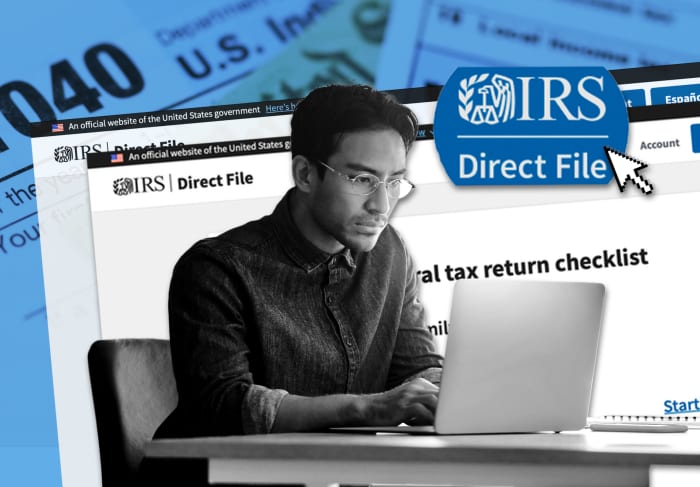The new no-frills, no-cost tax-filing platform that lets people file their taxes directly with the Internal Revenue Service gets straight to the point.
Need to file taxes on W-2 job wages while claiming some common tax credits and breaks? You can do it with Direct File, the free online tax-prep program the IRS will launch this March in 12 states.
But if you need to report gig-work income, stock proceeds or crypto sales, or claim credits for child-care costs, you better look elsewhere.
That was a key takeaway after the IRS and Treasury Department officials gave reporters an early look at Direct File, a free, government-run tax-prep service that’s designed to be similar to commercial versions from Intuit
INTU,
IRS Commissioner Danny Werfel said he hoped the sneak peek of Direct File showed a platform built to be “secure, accurate, easy to use and always free.”
Both TurboTax and H&R Block have said the IRS shouldn’t get into the tax-prep business when there are already many free filing options, including their own services, which can be free for taxpayers who qualify.
But some consumer advocates and regulators have questioned how many people really wind up paying no fees when they use services like TurboTax. There’s also an existing IRS partnership with certain software companies to provide free filing services, but few taxpayers take advantage of it, reports show.
Tax prep is no small investment in either money or time: In 2023, individual tax-filers spent an average of $150 and nine hours on doing their taxes, according to IRS estimates.
Direct File, funded in part by IRS budget increases resulting from the Inflation Reduction Act, is meant to provide an easy and free option. But it’s not one that every taxpayer can use.
Could it work for you? Here’s what to know after an early look by MarketWatch.
Who can use Direct File?
The official start of tax season is Jan. 29, when the IRS starts accepting tax returns. But Direct File won’t be available to the general public until March, according to IRS and Treasury officials. Before that, a group of government workers will be the first to test the program.
When it does become more widely available, eligibility will be based on location. The Direct File program will be available to people living in Florida, Nevada, New Hampshire, South Dakota, Tennessee, Texas, Washington state and Wyoming — all places with no state income taxes.
The program will also be available in Arizona, California, Massachusetts and New York, four states that assess their own income taxes. For these users, the Direct File program will send them to a state-run site to do their state return for free. After Washington users complete their federal return, they are sent to a state-run site to claim a state credit geared toward working families.
How does Direct File work?
Direct File isn’t built for every type of tax circumstance, so screening questions on things like income sources are intended to quickly eliminate people who can’t use the program.
Designers didn’t want users getting too deep into the filing process and then realizing it couldn’t handle certain information, officials said.
Users need to set up an ID.me account if they don’t have one already. The IRS already uses ID.me accounts for other online help tools.
Direct File can handle returns reporting wage income paid by an employer, which shows on a W-2 tax form. It can do multiple W-2s and there’s no income limit, officials noted.
However, it doesn’t handle independent-contractor income, which would be reported on tax forms like the 1099-NEC. That means people who make money in the gig economy can’t use Direct File; it won’t work for users who try to report tip income, either. Users who try to include income sources that aren’t supported by the program will see a pop-up screen alerting them that Direct File isn’t the fit for them.
However, the platform will handle jobless benefits, which count as taxable income. And it will work for Social Security recipients who may also need to pay taxes on their benefits, depending on the full amount of money coming to their household from other sources like jobs and investments. Direct File can fold both of these income sources into a return, along with interest income up to $1,500.
Interest amounts above that threshold require another piece of tax paperwork that the Direct File system can’t apply, officials said. For now, the program can’t handle extensions or amended returns, they said.
Users who get stumped on certain points — like what a certain question is asking — will be able to chat live with a person, officials noted. These customer-service representatives can’t give tax advice and don’t have access to caller’s tax account.
Which tax breaks can Direct File handle?
Some important ones, but certainly not all.
Direct File can apply the widely used standard deduction, but not itemized deductions. It can work in deductions on student-loan interest and, for teachers, a deduction worth up to $300 on unreimbursed job expenses.
Direct File will also let users claim the earned-income tax credit and the child tax credit. The child tax credit could become more generous for low-income families in their upcoming tax returns if Congress passes a bill tweaking the credit, which is gaining steam on Capitol Hill. If it becomes law, Werfel said it would take less than a day to update the child tax credit rules inside the Direct File program.
However, Direct File cannot handle credits for people seeking to defray some of their child-care costs or the “saver’s credit” aimed at lower-income households contributing to retirement accounts.
The program will not work for credits like the premium tax credit, intended for people who buy health insurance through the exchange created by the Affordable Care Act, known as Obamacare. That’s why Direct File has an initial screening question about a user’s health-insurance coverage.
How does using Direct File affect my tax refund or tax bill?
The returns filed through Direct File don’t get inside-track treatment, IRS officials said. For example, there’s no way for people to get their refund any faster if they use the Direct File program, they noted.
One critique from skeptics is that the IRS shouldn’t be trusted to spot the best ways to shave tax liability and boost refunds if it’s the one doing the return.
In one instance during the demonstration for reporters, the platform recommended a different type of filing status to boost a theoretical user’s refund.
Of course, that’s just one anecdote. Yet Werfel and other officials say Direct File puts a big emphasis on showing its math along the way and explaining the results.
“Direct File is designed to be transparent at every step and show the work behind the calculation, so users can be confident the return is complete and accurate,” Werfel said.
Now, the question is whether taxpayers will take the IRS up on its free tax-prep offer. IRS officials expect several hundred thousand people to use it.







